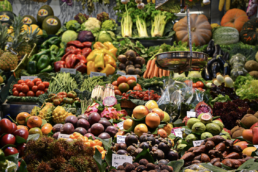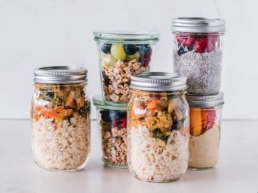By Jenny Fowler, First Mile Care DPP Coach
In the First Mile Care Diabetes Prevention Program (DPP), we frequently discuss diet. But the DPP is not a dieting program. When we talk about “diet” we mean nutrition. While modest weight loss (a minimum of 5%) and modest activity (at least 150 minutes per week) are core goals of the year-long program, the DPP focuses on good nutrition and healthy eating, not dieting. The goal is lifestyle change. We want participants to learn to make healthy, sustainable choices in relation to nutrition and fitness that will prevent or reverse chronic health conditions like prediabetes.
Your body needs both macronutrients and micronutrients to function. The body’s systems (e.g. digestive system, immune system, etc.) rely on nutrients and will use your body’s nutrient reserves if not getting enough from your diet. Nutritionally speaking, you want to eat a varied diet and the more variety, the better. Whole, unprocessed foods have a unique variety of nutrients that you need for optimal health.
Variety for vitamins
Your aim is to ensure that every meal has the ideal balance of about 50% fruit and/or vegetables, 25% starches, and 25% protein. It’s also essential to include some fats in the form of nuts, olives, avocados, coconut oil, and olive oil. A balance of macronutrients (proteins, carbs, fat) is obvious when looking at your plate, but in terms of micronutrients, you want to include multiple fruits and vegetables in your meal plan.
Different colors of fruit and vegetables are your clue to different compositions of vitamins and minerals. For example, vitamin A can be found in orange foods such as butternut squash and carrots, while a good source of vitamin K is dark, leafy greens like kale. On the other hand, while grains have some variety of nutrient composition, they are all high in the B vitamins so you don’t need to pay as much attention to grain variety.
Eating organically
To evolve your meals seasonally, try to shop at your local farmers market where you’ll be introduced to new fruits and vegetables as time passes. But whether at the farmers market or in a supermarket, consider buying some of your produce organic if you can. Conventionally grown foods can have pesticide residue that may cause inflammation, allergies, and lead to chronic health issues.
The Environmental Working Group (EWG) issues consumer guides to shopping for produce that are useful to bookmark on your smartphone and consult before selecting produce. The EWG Dirty DozenTM of fruits and vegetables have the highest levels of pesticide residue. The Dirty Dozen list for 2021 includes strawberries; spinach; kale, collard and mustard greens; nectarine; apples; grapes; cherries; peaches; pears; bell and hot peppers; celery; and tomatoes. These frequently make the list year after year. For that reason, the EWG recommends you try to buy these items organically grown whenever possible.
There is a companion list, the Clean 15TM, with the lowest pesticide residue. In 2021 this list includes avocados; sweet corn; pineapple; onions; papaya; frozen sweet peas; eggplant; asparagus; broccoli; cabbage; kiwi; cauliflower; mushrooms; honeydew melon; and cantaloupe.
Look to the rainbow
There’s really no downside nutritionally to eating an ultra-varied diet. However, if you’re a single person shopping for one, there may be a financial downside since eating a variety of foods means buying a variety of ingredients. You may choose to eat meals on repeat simply to avoid wasting food or having to spend too much time on meal prep. If so, the main thing is to make sure you’re getting different colors in your diet like red apples, orange carrots, yellow bell peppers, dark green kale, and blueberries. Whether you change your menu every day or eat the same meal three days running, make your plate as colorful as possible.
To learn more about how you can benefit from the First Mile Care Diabetes Prevention Program, take the prediabetes risk test and get started today!



